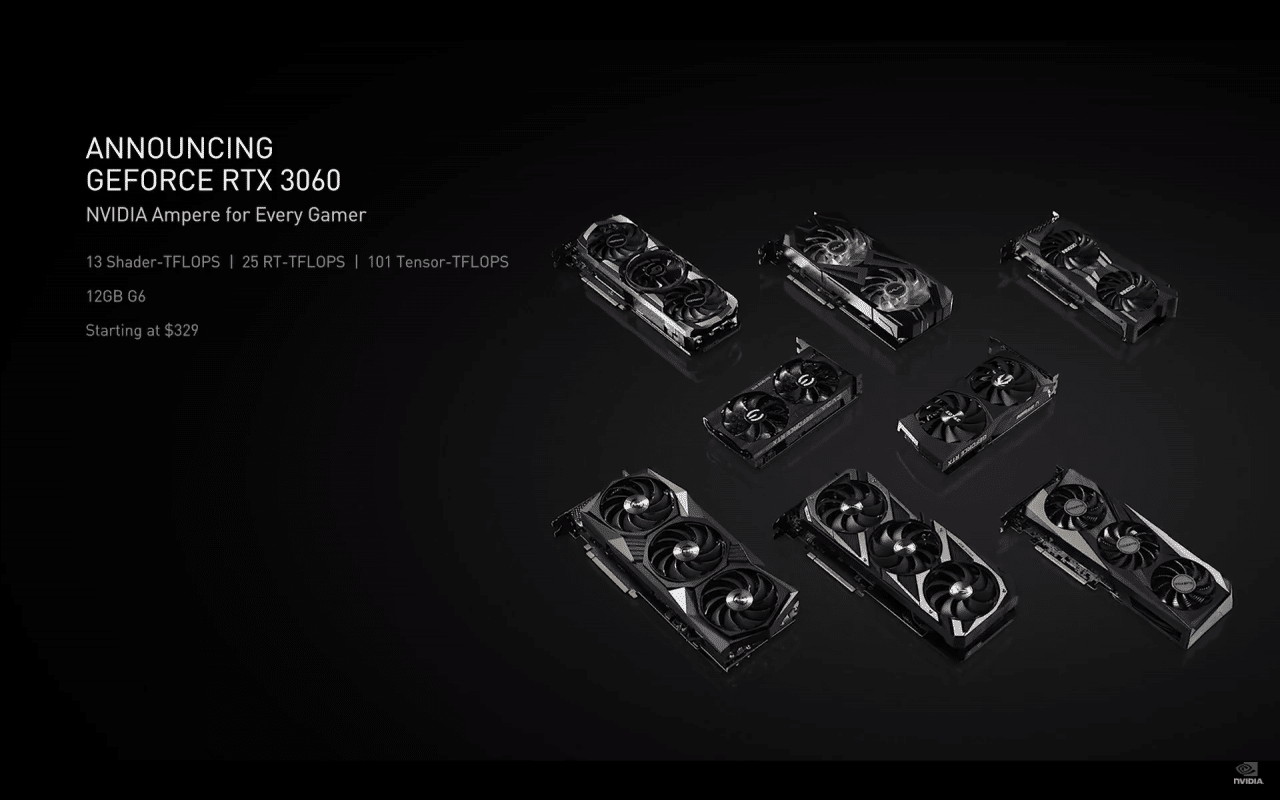The autumn of 2020 was characterized by a hardware cavalcade from AMD and Nvidia, which both released several new graphics cards. From Nvidia’s side the large architecture Ampere on the menu and until today, Geforce RTX 3090, RTX 3080, RTX 3070 and RTX 3060 Ti have been launched. Nvidia is now officially unveiling the RTX 3060.
In the short presentation of the graphics card, Nvidia talks about the Geforce RTX 2060 and GTX 1060, two models that, thanks to their prices in relation to performance, have been bestsellers and are still in many computers today. The newcomer RTX 3060 is seen as the natural upgrade route for those who sit on one of these graphics cards.
According to Nvidia, both models were good for their time, but not enough for the year 2021. As an example of this, the company shows the performance in six different games, four of which use both Ray Tracing and DLSS. As expected, the GTX 1060, which lacks hardware support, then sinks like a stone in these scenarios. The situation is not quite as difficult for RTX 2060.
Specifications: Nvidia Geforce RTX 3060
RTX 3070 | RTX 3060 Ti | RTX 3060 | RTX 2060 Super | |
|---|---|---|---|---|
Technical | 8 nm Samsung | 8 nm Samsung | 8 nm Samsung | 12 nm TSMC |
Circuit | GA104 | GA104 | GA106 | TU104 |
Circuit surface | 392 mm² | 392 mm² | ? | 445 mm² |
Transistors | 17.4 billion | 17.4 billion | ? | 10.6 billion |
Architecture | Ampere | Ampere | Ampere | Turing |
CUDA cores | 5 888 st. | 4 864 st. | 3 584 st. | 2 176 st. |
RT cores | 46 st. | 38 st. | 28 st. | 34 st. |
Tensor cores | 184 st. | 152 st. | 112 st. | 272 st. |
Texture units | 184 st. | 152 st. | 112 st. | 136 st. |
Raster units | 96 st. | 80 st. | 64 st. | 64 st. |
Clock frequency | 1 500 MHz | 1 410 MHz | 1 320 MHz | 1 470 MHz |
GPU Boost | 1 725 MHz | 1 665 MHz | 1 777 MHz | 1 650 MHz |
Calculating power (FP32) | 20 313 GFLOPS | 16 197 GFLOPS | 12 738 GFLOPS | 7 181 GFLOPS |
Memory bus | 256-bit | 256-bit | 192-bit | 256-bit |
Memory amount | 8 GB GDDR6 | 8 GB GDDR6 | 12 GB GDDR6 | 8 GB GDDR6 |
Memory frequency | 14 000 MHz | 14 000 MHz | 15 000 MHz | 14 000 MHz |
Memory bandwidth | 448 GB/s | 448 GB/s | 360 GB/s | 448 GB/s |
TBP | 220 W | 200 W | 170 W | 175 W |
Rec. Award | 499 USD | 399 USD | 329 USD | 399 USD |
Nvidia’s Geforce RTX 3060 is equipped with 12 GB of GDDR6 memory, which is 4 GB more than its big brother RTX 3060 Ti. However, this is accompanied by a memory bus of 192 bits, which reduces the potential bandwidth by a quarter. The theoretical computing power is around 13 TFLOPS, with the turbo frequency around 1,777 MHz and 3,584 CUDA cores true.
On the product side, a recommended price of SEK 3,500 and up is stated, but where the price level starts when the graphics card reaches the store shelves remains to be seen. Several third-party models appear in the imagery, but dimensions and images of a Founders Edition variant shine with their absence. Whether such a person will connect later, the future will show. The launch will take place at the end of February.
















